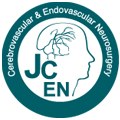- Apply for Authority
- P-ISSN2234-8565
- E-ISSN2287-3139
 ISSN : 2234-8565
ISSN : 2234-8565
Spontaneous occlusion of a pial arteriovenous fistula after angiography: The role of iodinated contrast media
Maiti Tanmoy Kumar (Department of Neurology and Neurointerventional Surgery, Neurological Institute, Cleveland Clinic, Abu Dhabi, United Arab Emirates)
Kesav Praveen (Department of Neurology and Neurointerventional Surgery, Neurological Institute, Cleveland Clinic, Abu Dhabi, United Arab Emirates)
Arif Ashna (School of Medicine, Queen’s University, Belfast, Ireland)
Hussain Syed Irteza (Department of Neurology and Neurointerventional Surgery, Neurological Institute, Cleveland Clinic, Abu Dhabi, United Arab Emirates)
- Downloaded
- Viewed
Abstract
Intracranial non-galenic pial arteriovenous fistula (PAVF) is an extremely rare vascular malformation, where one or more pial arteries feeds directly into a cortical vein without any intervening nidus. Though occasionally they can be asymptomatic, neurological symptoms such as headache, seizure, or focal neurological deficit are more common presenting features. Life threatening or fatal hemorrhage is not uncommon, hence needed to be treated more often than not. Spontaneous occlusion of PAVF is reported only four times before. We report a 49-year-old gentleman, who was diagnosed to have a PAVF, possibly secondary to trauma. He presented 5 months and 22 days from initial digital subtraction angiography (DSA) for treatment, and follow-up angiogram showed complete obliteration. He denied any significant event, medication or alternate treatment during this period. His clinical symptoms were stable as well. We postulate iodinated contrast medium induced vasculopathy as a possible cause, which has been described for other vascular pathologies, but never for PAVF.
- keywords
- Central nervous system vascular malformations, Pial arteriovenous fistula, Spontaneous occlusion, Contrast agents, Iodine
- Downloaded
- Viewed
- 0KCI Citations
- 0WOS Citations
